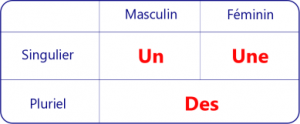Difference between revisions of "Language/French/Grammar/Indefinite-article"
Jump to navigation
Jump to search
| Line 1: | Line 1: | ||
[[File:French-Language-PolyglotClub.png|thumb]] | [[File:French-Language-PolyglotClub.png|thumb]] | ||
[[File:indefinite-article-in-french-polyglotclub.png|thumb]] | |||
<div style="font-size:300%">Indefinite article in French</div> | <div style="font-size:300%">Indefinite article in French</div> | ||
__TOC__ | __TOC__ | ||
Revision as of 23:31, 3 December 2021
Indefinite article in French
French Articles
French has 3 kinds of articles:
- Definite articles
- Indefinite articles
- Partitive articles
The table below summarizes the different forms:
| French Articles | |||
|---|---|---|---|
| Definite article | Indefinite article | Partitive | |
| masculine | le | un | du |
| feminine | la | une | de la |
| in front of a vowel | l' | un/une | de l' |
| plural | les | des | des |
Indefinite Article : Rule & Examples
In French, nouns are almost always preceded by an article or a determiner. This indicates the gender of the noun (masculine or feminine) and its number (singular or plural).
We use the indefinite articles (articles indéfinis) in the following cases:
To talk about something non-specific:
- Céline est une copine de Noémie. (one of many)
Céline is a friend of Noémie. (one of many)
To mention something for the first time in a text:
- Jean a acheté une moto.
Jean bought a motorbike.
In can be translated by “a” or “an” in English.
Video - French Indefinite Article / How to say “a” or “an” in French
Learn how to say “a” or “an” in French
- Similar lessons : Definite article & Indefinite article
- More on this subject: Typical use of the indefinite article

